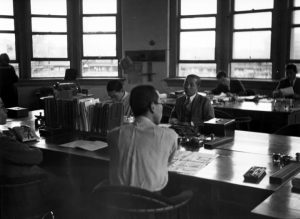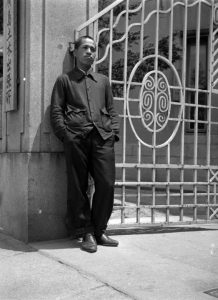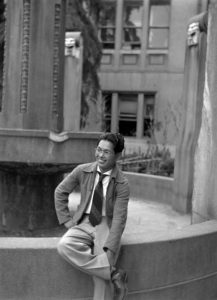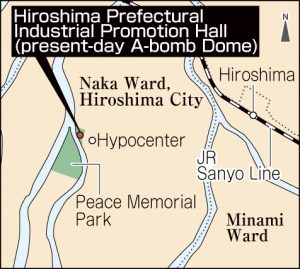Striving to fill voids in Hiroshima—Recreating cityscapes: Photos taken pre-bombing by worker at Industrial Promotion Hall (A-bomb Dome) donated to Peace Memorial Museum
Jan. 4, 2023
Archived negatives include shots of shopping district
by Kyosuke Mizukawa, Senior Staff Writer
A total of 26 photographs depicting the Hiroshima Prefectural Industrial Promotion Hall, now known as the A-bomb Dome, a World Heritage site in the city’s centrally located Naka Ward, and the busy Hondori shopping street in the same area, have been donated to the Hiroshima Peace Memorial Museum (Naka Ward). The photos were taken around three to four years before the U.S. military dropped the atomic bomb on the city and include unique shots of people at work in the offices that had been located in the Industrial Promotion Hall. The images were taken by a man who had worked there. The photographic negatives also remain, even as few other negatives taken of Hiroshima before the atomic bombing have ever been found. According to museum staff, the precious materials provide a wealth of information about Hiroshima as it was prior to the bombing.
Hideo Kokawa, who died in 2014 at the age of 93, was the photographer in question. Mr. Kokawa worked at the Hiroshima branch office of the Japan Trade Promotion Association, located on the second floor of the hall. Most of the photos capture the hall, including the branch office with its unique, expansive windows, the gate at the building’s north entrance, and a Western-style garden located on the south end of the hall.
Mr. Kokawa began work at the branch office around the spring of 1941 and took the photos up until he was drafted into military service at the end of 1942. According to the museum, his photos of offices in the hall were the closest taken of work inside the hall before the atomic bombing of all the pre-bombing photos that the museum has in its collections. Mr. Kokawa held on to the photographic negatives at his home in the city even after the end of the war. In 1998, a Chugoku Shimbun article introduced a portion of his photos.
In the fall of 2022, the Peace Memorial Museum returned its attention to the newspaper article and sought cooperation from Hideharu Kokawa, 73, Hideo’s oldest son, a resident of Hiroshima’s Asakita Ward who inherited the photographic materials. After Hideharu agreed to donate the images, the museum borrowed the negatives, scanned them, and archived the electronic image data.
A museum official said, “We were able to develop high-resolution photos from the rare negatives, which give us greater insight into the lives of people in those days through their details, such as the facial expressions and clothing of members of the public, as well as words written on signboards. Our hope is that viewers can compare his photos with those taken after the atomic bombing and reflect on what was lost as a result of the bombing.”
(Originally published on January 4, 2023)











